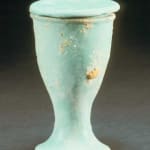18th Dynasty Faience Lidded Ointment Jar, 1550 BCE - 1295 BCE
Faience
X.0332
Faience, which dates back to pre-dynastic times, of at least 5,000 years, is a glasslike non-clay substance made of materials common to Egypt: ground quartz, crushed quartz pebbles, flint, a...
Faience, which dates back to pre-dynastic times, of at least 5,000 years, is a glasslike non-clay substance made of materials common to Egypt: ground quartz, crushed quartz pebbles, flint, a soluble salt-like baking soda, lime and ground copper, which provided the characteristic color. The dried objects went into kilns looking pale and colorless but emerged a sparkling "Egyptian blue." Called tjehnet by the ancient Egyptians, meaning that which is brilliant or scintillating, faience was thought to be filled with the undying light of the sun, moon and stars and was symbolic of rebirth. Ancient Egyptians believed the small blue-green objects helped prepare them for eternity in the afterlife.
The body of this gorgeous turquoise-hued faience vessel has a cylindrical form that tapers downward and flares outwards at the base. The cylindrical jar is one of the most common forms of Egyptian containers that were first created in terracotta and later carved from stone. Generally, these types of vessels were used to contain valuable unguents, as is likely with this beautiful example. From the 6th Dynasty onwards, lids appeared. This ointment jar features an internally rimmed lid that fits securely into the mouth of the container. Thus, such jars were meant not only to hold, but also to preserve their precious contents. Considering the diminutive nature of this container, it most probably functioned specifically as a funerary offering, standing in place of its larger, everyday counterpart. Surely this interpretation would be in keeping with the luxury of the material and the presence of the text. Faience works were often interred with the deceased in order to provide for the afterlife, so that we would continue to be surrounded in the next world with the things we held dear in this one.
The body of this gorgeous turquoise-hued faience vessel has a cylindrical form that tapers downward and flares outwards at the base. The cylindrical jar is one of the most common forms of Egyptian containers that were first created in terracotta and later carved from stone. Generally, these types of vessels were used to contain valuable unguents, as is likely with this beautiful example. From the 6th Dynasty onwards, lids appeared. This ointment jar features an internally rimmed lid that fits securely into the mouth of the container. Thus, such jars were meant not only to hold, but also to preserve their precious contents. Considering the diminutive nature of this container, it most probably functioned specifically as a funerary offering, standing in place of its larger, everyday counterpart. Surely this interpretation would be in keeping with the luxury of the material and the presence of the text. Faience works were often interred with the deceased in order to provide for the afterlife, so that we would continue to be surrounded in the next world with the things we held dear in this one.



